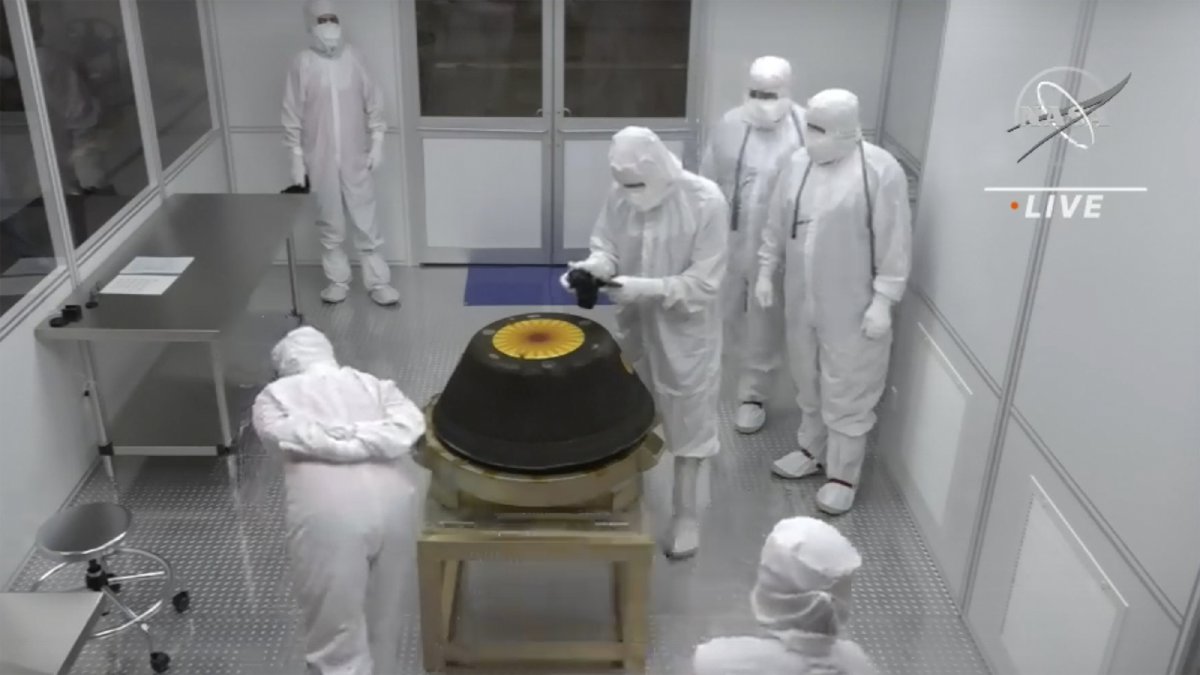
In this image from video provided by NASA, technicians in a clean room examine the sample return capsule from NASA’s Osiris-Rex mission after it landed at the Department of Defense’s Utah Test and Training Range on Sunday, Sept. 24, 2023. The sample was collected from the asteroid Bennu in October 2020.
9:06 JST, September 25, 2023
NASA’s first asteroid samples fetched from deep space parachuted into the Utah desert Sunday to cap a seven-year journey.
In a flyby of Earth, the Osiris-Rex spacecraft released the sample capsule from 63,000 miles (100,000 kilometers) out. The small capsule landed four hours later on a remote expanse of military land, as the mothership set off after another asteroid.
“We have touchdown!” Mission Recovery Operations announced, immediately repeating the news since the landing occurred three minutes early. Officials later said the orange striped parachute opened four times higher than anticipated — around 20,000 feet (6,100 meters) — basing it on the deceleration rate.
To everyone’s relief, the capsule was intact and not breached, keeping its 4.5 billion-year-old samples free of contamination. Within two hours of touchdown, the capsule was inside a temporary clean room at the Defense Department’s Utah Test and Training Range, hoisted there by helicopter.
The sealed sample canister will be flown on Monday to NASA’s Johnson Space Center in Houston, where it will be opened in a new, specially designed lab. The building already houses the hundreds of pounds (kilograms) of moon rocks gathered by the Apollo astronauts.
“We can’t wait to crack into it. For me, the real science is just beginning,” said the mission’s lead scientist, Dante Lauretta of the University of Arizona. He’ll accompany the samples all the way to Texas.
Lori Glaze, NASA’s planetary science division director, added: “Those are going to be a treasure for scientific analysis for years and years and years to come.”
Scientists estimate the capsule holds at least a cup of rubble from the carbon-rich asteroid known as Bennu, but won’t know for sure until the container is opened in a day or two. Some spilled and floated away when the spacecraft scooped up too much material, which jammed the container’s lid during collection three years ago.
Japan, the only other country to bring back samples, gathered about a teaspoon during a pair of asteroid missions.
The pebbles and dust delivered Sunday represent the biggest haul from beyond the moon. Preserved building blocks from the dawn of our solar system, the samples will help scientists better understand how Earth and life formed, providing “an extraordinary glimpse” of 4.5 billion years ago, said NASA Administrator Bill Nelson.
Osiris-Rex, the mothership, rocketed away on the $1 billion mission in 2016. It reached Bennu two years later and, using a long stick vacuum, grabbed rubble from the small roundish space rock in 2020. By the time it returned, the spacecraft had logged 4 billion miles (6.2 billion kilometers).
At a news conference several hours later, Lauretta said he broke into tears of joy upon hearing that the capsule’s main parachute had opened.
“I knew we had made it home,” he said, so overwhelmed with emotion when he arrived at the scene that he wanted to hug the capsule, sooty but undamaged and not even bent.
Flight controllers for spacecraft builder Lockheed Martin stood and applauded the touchdown from their base in Colorado. NASA camera views showed the charred capsule upside down on the sand with its parachute disconnected and strewn nearby, as the recovery team moved in via helicopters.
“Boy, did we stick that landing,” Lauretta said. “It didn’t move, it didn’t roll, it didn’t bounce. It just made a tiny little divot in the Utah soil.”
British astronomer Daniel Brown, who was not involved in the mission, said he expects “great things” from NASA’s largest sample return since the Apollo moon landings more than a half-century ago. With these asteroid samples, “we are edging closer to understanding its early chemical composition, the formation of water and the molecules life is based on,” he added from Nottingham Trent University.
One Osiris-Rex team member was stuck in England, rehearsing for a concert tour. “My heart’s there with you as this precious sample is recovered,” Queen’s lead guitarist Brian May, who’s also an astrophysicist, said in a prerecorded message. “Happy Sample Return Day.”
Engineers estimate the canister holds 250 grams (8.82 ounces) of material from Bennu, plus or minus 100 grams (3.53 ounces). Even at the low end, it will easily surpass the minimum requirement of the mission, Lauretta said.
It will take a few weeks to get a precise measurement, said NASA’s lead curator Nicole Lunning.
NASA plans a public show-and-tell in October.
Currently orbiting the sun 50 million miles (81 million kilometers) from Earth, Bennu is about one-third of a mile (one-half of a kilometer) across, roughly the size of the Empire State Building but shaped like a spinning top. It’s believed to be the broken fragment of a much larger asteroid.
During a two-year survey, Osiris-Rex found Bennu to be a chunky rubble pile full of boulders and craters. The surface was so loose that the spacecraft’s vacuum arm sank a foot or two (0.5 meters) into the asteroid, sucking up more material than anticipated.
These close-up observations may come in handy late next century. Bennu is expected to come dangerously close to Earth in 2182 — possibly close enough to hit. The data gleaned by Osiris-Rex will help with any asteroid-deflection effort, according to Lauretta.
Osiris-Rex is already chasing after the asteroid Apophis, and will reach it in 2029.
This was NASA’s third sample return from a deep-space robotic mission. The Genesis spacecraft dropped off bits of solar wind in 2004, but the samples were compromised when the parachute failed and the capsule slammed into the ground. The Stardust spacecraft successfully delivered comet dust in 2006.
NASA’s plans to return samples from Mars are on hold after an independent review board criticized the cost and complexity. The Martian rover Perseverance has spent the past two years collecting core samples for eventual transport to Earth.
"News Services" POPULAR ARTICLE
-

American Playwright Jeremy O. Harris Arrested in Japan on Alleged Drug Smuggling
-

Taiwan President Shows Support for Japan in China Dispute with Sushi Lunch
-

Japan Trying to Revive Wartime Militarism with Its Taiwan Comments, China’s Top Paper Says
-

Japan’s Nikkei Stock Average as JGB Yields, Yen Rise on Rate-Hike Bets
-

Japan’s Nikkei Stock Average Licks Wounds after Selloff Sparked by BOJ Hike Bets (UPDATE 1)
JN ACCESS RANKING
-

Govt Plans to Urge Municipalities to Help Residents Cope with Rising Prices
-

Essential Services Shortage to Hit Japan’s GDP By Up to ¥76 Tril. By 2040
-

Japan Prime Minister Takaichi Vows to Have Country Exit Deflation, Closely Monitor Economic Indicators
-

Japan to Charge Foreigners More for Residence Permits, Looking to Align with Western Countries
-

Japan GDP Down Annualized 1.8% in July-Sept.






















